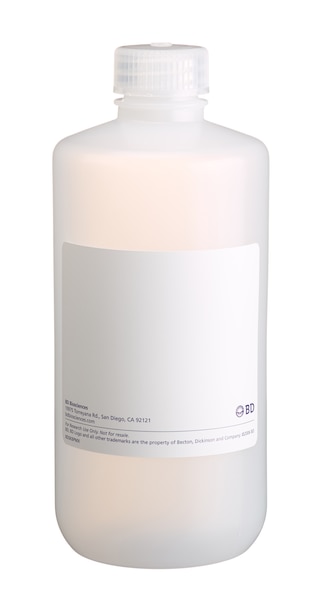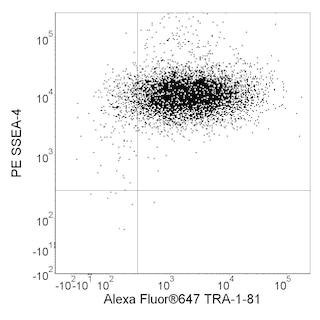-
Reagents
- Flow Cytometry Reagents
-
Western Blotting and Molecular Reagents
- Immunoassay Reagents
-
Single-Cell Multiomics Reagents
- BD® AbSeq Assay
- BD Rhapsody™ Accessory Kits
- BD® Single-Cell Multiplexing Kit
- BD Rhapsody™ Targeted mRNA Kits
- BD Rhapsody™ Whole Transcriptome Analysis (WTA) Amplification Kit
- BD Rhapsody™ TCR/BCR Profiling Assays for Human and Mouse
- BD® OMICS-Guard Sample Preservation Buffer
- BD Rhapsody™ ATAC-Seq Assays
-
Functional Assays
-
Microscopy and Imaging Reagents
-
Cell Preparation and Separation Reagents
-
Training
- Flow Cytometry Basic Training
-
Product-Based Training
- BD FACSDiscover™ S8 Cell Sorter Product Training
- Accuri C6 Plus Product-Based Training
- FACSAria Product Based Training
- FACSCanto Product-Based Training
- FACSLyric Product-Based Training
- FACSMelody Product-Based Training
- FACSymphony Product-Based Training
- HTS Product-Based Training
- LSRFortessa Product-Based Training
- Advanced Training
-
- BD® AbSeq Assay
- BD Rhapsody™ Accessory Kits
- BD® Single-Cell Multiplexing Kit
- BD Rhapsody™ Targeted mRNA Kits
- BD Rhapsody™ Whole Transcriptome Analysis (WTA) Amplification Kit
- BD Rhapsody™ TCR/BCR Profiling Assays for Human and Mouse
- BD® OMICS-Guard Sample Preservation Buffer
- BD Rhapsody™ ATAC-Seq Assays
-
- BD FACSDiscover™ S8 Cell Sorter Product Training
- Accuri C6 Plus Product-Based Training
- FACSAria Product Based Training
- FACSCanto Product-Based Training
- FACSLyric Product-Based Training
- FACSMelody Product-Based Training
- FACSymphony Product-Based Training
- HTS Product-Based Training
- LSRFortessa Product-Based Training
- United States (English)
-
Change country/language
Old Browser
This page has been recently translated and is available in French now.
Looks like you're visiting us from {countryName}.
Would you like to stay on the current country site or be switched to your country?
BD Stemflow™ Human MSC Analysis Kit
(RUO)



Top: Schematic workflow of the human MSC analysis kit. Bottom: Cells grown in BD Mosaic™ hMSC SF Cell Culture Environment (Cat. No. 355700) were detached using BD™ Accutase™ Cell Detachment Solution (Cat. No 561527) and then stained with the positive and negative cocktails (solid lines) or the positive and negative isotype control cocktails (dashed lines). The plots were derived from gated events based on light scattering characteristics of the MSCs. Cells were analyzed using a BD™ LSRII flow cytometry system.


BD Stemflow™ Human MSC Analysis Kit

Human MSC Analysis Kit
Regulatory Status Legend
Any use of products other than the permitted use without the express written authorization of Becton, Dickinson and Company is strictly prohibited.
Description
Human multipotent mesenchymal stromal cells (MSCs), also referred to as mesenchymal stem cells, are a rare population of adult stem cells that can be isolated from a variety of tissues. MSCs that have been isolated from bone marrow and subsequently cultured can differentiate to a variety of cell types, most notably adipocytes, osteocytes and chondrocytes. MSCs also have immunomodulatory effects in vivo and in vitro. In 2006, the International Society for Cellular Therapy (ISCT) proposed a cell surface marker panel for the minimal identification of human MSCs derived from bone marrow. Under this recommendation MSCs should be positive for CD73, CD90, and CD105, but be negative for CD34, CD45, CD11b or CD14, CD19 or CD79α, and HLA-DR. MSCs are also known to express numerous cell surface markers such as CD44, CD29, CD200, CD166, CD146 and CD271. In this kit we include the panel that was proposed by the ISCT. In addition, we designed this kit to be modular so that additional markers could be "dropped-in". Specifically, the MSC positive cocktail (FITC CD90, PerCP-Cy™5.5 CD105 and APC CD73) leaves the PE channel open to use in combination with the supplied negative MSC cocktail (PE CD45, PE CD34, PE CD11b, PE CD19 and PE HLA-DR), the included PE CD44 antibody conjugate, or a variety of other commercially available PE antibody conjugates. Multi color analysis minimizes cell numbers required for an assay and antibody cocktails facilitate a streamlined staining protocol to analyze multiple samples. Individual positive markers are included for compensation set-up.
Kit Components
Component Description Size Vol. Per Test Storage Buffer
51-9007661 PE hMSC Negative Cocktail 50 Test 20 µl Aqueous buffered solution containing
BSA and ≤0.09% sodium azide
51-9007662 PE hMSC Isotype Control Negative Cocktail 50 Test 20 µl Aqueous buffered solution containing
BSA and ≤0.09% sodium azide
51-9007663 hMSC Positive Cocktail 50 Test 20 µl Aqueous buffered solution containing
BSA and ≤0.09% sodium azide
51-9007664 hMSC Isotype Control Positive Cocktail 50 Test 20 µl Aqueous buffered solution containing
BSA and ≤0.09% sodium azide
51-9007657 FITC Mouse Anti-Human CD90 50 Test 5 µl Aqueous buffered solution containing
BSA and ≤0.09% sodium azide
51-9007656 PE Mouse Anti-Human CD44 100 Test 5 µl Aqueous buffered solution containing BSA,
protein stabilizer, and ≤0.09% sodium azide
51-9007655 PE Mouse IgG2b, k Isotype Control 50 Test 5 µl Aqueous buffered solution containing
BSA and ≤0.09% sodium azide
51-9007649 APC Mouse Anti-Human CD73 50 Test 5 µl Aqueous buffered solution containing
BSA and ≤0.09% sodium azide
51-9007648 PerCP-Cy™5.5 Mouse Anti-Human CD105 50 Test 5 µl Aqueous buffered solution containing
(Endoglin) BSA and ≤0.09% sodium azide
Description of Kit Components
Vial Contents Purpose
hMSC Positive Cocktail CD90 FITC (Clone: 5E10) Cocktail to positively identify hMSCs
CD105 PerCP-Cy5.5 (Clone: 266)
CD73 APC (Clone: AD2)
hMSC Positive Isotype Control Cocktail mIgG1, κ FITC (Clone: X40) Corresponding Isotype Control for hMSC Positive mIgG1, κ PerCP-Cy5.5 (Clone: X40) Cocktail
mIgG1, κ APC (Clone: X40)
PE hMSC Negative Cocktail CD34 PE (Clone:581) Cocktail to identify potential contaminants
CD11b PE (Clone: ICRF44)
CD19 PE (Clone: HIB19)
CD45 PE (Clone: HI30)
HLA-DR PE (Clone: G46-6)
PE hMSC Negative Isotype Control Cocktail mIgG1, κ PE (Clone: X40) Corresponding isotype control for PE hMSC
mIgG2a, κ PE (Clone:G155-178) Negative Cocktail
FITC Mouse Anti-human CD90 CD90 FITC (Clone: 5E10) Compensation control
PE Mouse Anti-Human CD44 CD44 PE (Clone: G44-26) Compensation control/MSC positive drop-in
PerCP-Cy™5.5 Mouse Anti-Human CD105 CD105 PerCP-Cy™5.5 (Clone: 266) Compensation control
APC Mouse Anti-Human CD73 CD73 APC (Clone:AD2) Compensation control
PE Mouse IgG2b, κ Isotype Control mIgG2b, κ (Clone: 27-35) Corresponding Isotype Control for PE Mouse
Anti-Human CD44, when used as a drop in
Preparation And Storage
Recommended Assay Procedures
(1) Detach cells using BD™ Accutase™ Cell Detachment Solution (Cat. No 561527) or similar detachment solution, wash cells and resuspend at
a concentration of 1x10^7 cells/ml in BD Pharmingen™ Stain Buffer (Cat. No. 554656) or other appropriate staining buffer.
(a) Cells can also be resuspended at a concentration of 5x10^6 cells/ml if cell number is a limiting factor.
(2) Label tubes and add antibodies as shown below:
Tube Add (1 test size)
(1) FITC Mouse Anti-Human CD90 (5µl)
(2) PE Mouse Anti-Human CD44 (5µl)
(3) PerCP-Cy™5.5 Mouse Anti-Human CD105 (5µl)
(4) APC Mouse Anti-Human CD73 (5µl)
(5) Nothing
(6) hMSC Positive Isotype Control Cocktail (20µl)
PE hMSC Negative Isotype Control Cocktail (20µl)
(7) hMSC Positive Cocktail (20µl)
PE hMSC Negative Cocktail (20µl)
And/or
(8) hMSC Positive Isotype Control Cocktail (20µl)
Drop in isotype control (i.e. PE Mouse IgG2b, κ) (5 µl)
(9) hMSC Positive Cocktail (20µl)
PE Drop in (i.e. PE Mouse Anti-Human CD44) (5µl)
(3) Repeat tubes 5-7 and/or 8-9 for each additional cell sample.
(4) Add 100 µl of prepared cell suspension to tubes 1 through 9.
(5) Incubate tubes in the dark for 30 minutes (May be done on ice or at room temp)
(6) Wash the cells twice with BD Pharmingen™ Stain Buffer (FBS) and resuspend at 300-500 µl in BD Pharmingen™ Stain Buffer (FBS) .
Alternatively, 1X Washing/Staining Solution (1 x PBS,1% FCS, and 0.09% sodium azide) may be used.
(7) Analyze cells on flow cytometer
(a) tubes 1-5 are to be used as controls to set up cytometer (i.e Compensation)
Product Notices
- Accutase is a registered trademark of Innovative Cell Technologies, Inc.
- Please observe the following precautions: Absorption of visible light can significantly alter the energy transfer occurring in any tandem fluorochrome conjugate; therefore, we recommend that special precautions be taken (such as wrapping vials, tubes, or racks in aluminum foil) to prevent exposure of conjugated reagents, including cells stained with those reagents, to room illumination.
- This APC-conjugated reagent can be used in any flow cytometer equipped with a dye, HeNe, or red diode laser.
- PerCP-Cy5.5 is optimized for use with a single argon ion laser emitting 488-nm light. Because of the broad absorption spectrum of the tandem fluorochrome, extra care must be taken when using dual-laser cytometers, which may directly excite both PerCP and Cy5.5™. We recommend the use of cross-beam compensation during data acquisition or software compensation during data analysis.
- PerCP-Cy5.5–labelled antibodies can be used with FITC- and R-PE–labelled reagents in single-laser flow cytometers with no significant spectral overlap of PerCP-Cy5.5, FITC, and R-PE fluorescence.
- Cy is a trademark of Amersham Biosciences Limited. This conjugated product is sold under license to the following patents: US Patent Nos. 5,486,616; 5,569,587; 5,569,766; 5,627,027.
- This product is subject to proprietary rights of Amersham Biosciences Corp. and Carnegie Mellon University and made and sold under license from Amersham Biosciences Corp. This product is licensed for sale only for research. It is not licensed for any other use. If you require a commercial license to use this product and do not have one return this material, unopened to BD Biosciences, 10975 Torreyana Rd, San Diego, CA 92121 and any money paid for the material will be refunded.
- Source of all serum proteins is from USDA inspected abattoirs located in the United States.
- Caution: Sodium azide yields highly toxic hydrazoic acid under acidic conditions. Dilute azide compounds in running water before discarding to avoid accumulation of potentially explosive deposits in plumbing.
- For fluorochrome spectra and suitable instrument settings, please refer to our Multicolor Flow Cytometry web page at www.bdbiosciences.com/colors.
- Please refer to www.bdbiosciences.com/us/s/resources for technical protocols.
Companion Products


Development References (5)
-
Bühring HJ, Battula VL, Treml S, Schewe B, Kanz L, Vogel W. Novel markers for the prospective isolation of human MSC. Ann N Y Acad Sci. 2007; 1106:262-271. (Biology: Flow cytometry). View Reference
-
Dominici M, Le Blanc K, Mueller I, et. al. Minimal criteria for defining multipotent mesenchymal stromal cells. The International Society for Cellular Therapy position statement. Cytotherapy. 2006; 8(4):315-317. (Biology: Flow cytometry). View Reference
-
Horwitz EM, Le Blanc K, Dominici M, et. al. Clarification of the nomenclature for MSC: The International Society for Cellular Therapy position statement. Cytotherapy. 2005; 7(5):393-395. (Biology). View Reference
-
Kern S, Eichler H, Stoeve J, Klüter H, Bieback K. Comparative analysis of mesenchymal stem cells from bone marrow, umbilical cord blood, or adipose tissue. Stem Cells. 2006; 24(5):1294-1301. (Biology: Flow cytometry). View Reference
-
Sánchez L, Gutierrez-Aranda I, Ligero G, et al. Enrichment of Human ESC-Derived Multipotent Mesenchymal Stem Cells with Immunosuppressive and Anti-Inflammatory Properties Capable to Protect Against Experimental Inflammatory Bowel Disease. Stem Cells. 2010; 29(2):251-262. (Biology: Cell differentiation). View Reference
Please refer to Support Documents for Quality Certificates
Global - Refer to manufacturer's instructions for use and related User Manuals and Technical data sheets before using this products as described
Comparisons, where applicable, are made against older BD Technology, manual methods or are general performance claims. Comparisons are not made against non-BD technologies, unless otherwise noted.
For Research Use Only. Not for use in diagnostic or therapeutic procedures.
Report a Site Issue
This form is intended to help us improve our website experience. For other support, please visit our Contact Us page.